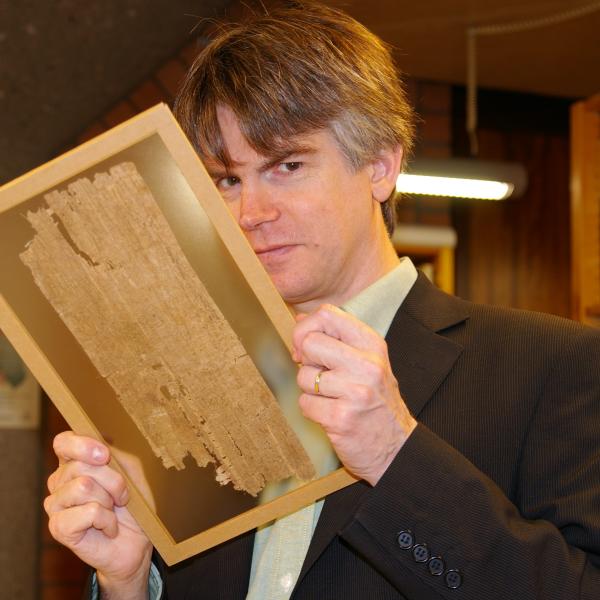The ancient Egyptian language is attested in Egypt for over four thousand years, from the appearance of Hieroglyphic writing around 3200 BCE, until it was gradually replaced by Arabic after the Arab conquest of Egypt in 641 CE. Ancient Egyptian is considered to be a branch of the Afro-Asiatic language family, meaning that ancient Egyptian has similarities to Akkadian, Arabic and Hebrew, and is quite different from Indo-European languages like English, French and German. Five stages of the ancient Egyptian language are recognized: Old Egyptian, Middle Egyptian, Late Egyptian, Demotic and Coptic. These were written in at least four different scripts: Hieroglyphs, Hieratic, Demotic and Coptic.
Ancient Egyptian was first written in the Hieroglyphic script, which famously utilizes signs that look like people, animals and natural and manmade objects, but actually represent consonantal and semi-vowel phonemes, groups of phonemes and classifiers. The earliest texts written in Hieroglyphs, from around 3200 BCE to 2600 BCE, consisted of names, labels and short accounts without much grammar. The first stage of ancient Egyptian with recognizable grammar is Old Egyptian, which was primarily used during the Old Kingdom from around 2600 BCE to 2100 BCE. Old Egyptian was written in Hieroglyphs and is best known from the funerary texts inscribed inside of royal burial chambers in pyramids and known as Pyramid Texts, and the autobiographies inscribed in private tombs.
The second stage of ancient Egyptian is Middle Egyptian, which replaced Old Egyptian during the Middle Kingdom from around 2100 BCE to 1500 BCE, probably as a result of changes in the spoken language. Middle Egyptian was written in both Hieroglyphs and Hieratic, a script that utilizes simplified, cursive versions of Hieroglyphic signs, adapted to be written easily and quickly with ink and brush on papyrus or ostraca (potsherds or flakes of stone used as writing material). Hieroglyphs tended to be used for inscriptions on monuments, like royal decrees and stelae, temple inscriptions, autobiographies in tombs, and even the funerary texts on coffins known as Coffin Texts. Hieratic tended to be used for letters, legal documents, accounts and literary texts written on papyri and ostraca.
The third stage of ancient Egyptian is Late Egyptian, which appeared during and after the New Kingdom, from around 1500 BCE to 700 BCE, again probably reflecting changes in the spoken language. Late Egyptian was used when scribes wanted to present an approximation of the spoken language, in letters, legal documents, accounts, and some literature. It could be written in Hieroglyphs, but most often it was written in Hieratic on papyri and ostraca. Middle Egyptian continued to be used alongside Late Egyptian, however, for religious texts like the Book of the Dead, historical inscriptions, and even some literary texts, either because they had become canonical, or because they emulated the style and prestige of the canonical texts.
The fourth stage of ancient Egyptian is Demotic, which replaced Late Egyptian during the Saite, Persian, Ptolemaic and Roman Periods, from around 700 BCE to 400 CE, again reflecting changes in the spoken language. Demotic was no longer written in Hieroglyphs or Hieratic, but instead used an even more cursive set of signs derived from Hieratic that was also called Demotic. Initially Demotic was only used for letters, legal documents and accounts, but in the Ptolemaic and Roman Periods it was also used for literary, historical and religious texts, restricting the use of Middle Egyptian, Hieroglyphs and Hieratic to some traditional religious texts and to temple inscriptions. Persian, Ptolemaic and Roman rulers of Egypt promoted the use of Aramaic and Greek in Egypt alongside Demotic, especially for administration, creating a multi-lingual society and monuments like the Rosetta Stone, inscribed in Hieroglyphs, Demotic and Greek.
The fifth and final stage of ancient Egyptian is Coptic, which replaced all earlier stages of the language during the Early Byzantine and Early Islamic Periods, from around 400 CE onwards. The decline of Egyptian temples and priesthoods in the Roman Period eliminated the cultural space for the older Egyptian language stages, scripts and texts, while Christian religious elites reached out to Egyptian speakers with a new language stage and texts written in a more familiar script. Coptic was written with letters derived from the Greek alphabet, familiar to Egyptians from centuries of Ptolemaic and Roman rule, supplemented by six additional signs derived from Demotic to represent phonemes that did not exist in Greek. Coptic was used for letters and legal documents, and especially for religious texts, some of them translations of canonical texts, some preserving non-canonical Gnostic and Manichaean texts and traditions, some of them original compositions in Coptic. Coptic gradually ceased to be spoken conversationally in Egypt during the Medieval Period, but it continues to be used as a liturgical language. Knowledge of Coptic, as well as the Rosetta Stone, was key to the modern decipherment of the older Egyptian language stages and scripts.
Egyptology at the University of Chicago
The study of ancient Egypt through its language is known as Egyptology. Egyptology is taught at the University of Chicago through the Department of Middle Eastern Studies. MES offers formal instruction in all of the stages of the ancient Egyptian language and associated scripts mentioned above. For those with no prior experience, the first year of instruction starts with Middle Egyptian, the classical stage of the language, and with the Hieroglyphic script, primarily used for monumental inscriptions. The second year of instruction introduces the more cursive Hieratic script, used for literary, administrative, and personal texts, and Old Egyptian or Late Egyptian. Advanced students are taught Ptolemaic Hieroglyphs, in which many new hieroglyphic signs had come into use, as well as Demotic and Coptic.
In addition to language courses, students of ancient Egyptian are also expected to take courses in ancient Egyptian history and culture, and Egyptian archaeology. Courses may also be offered on specific cultural topics such as Egyptian Thought and Literature, Egyptian Religion, Women in Ancient Egypt, Epigraphy, Deir el-Medina, the Temple of Medinet Habu, etc.
For 40 years, students have had the opportunity to participate in the collecting of data for the Chicago Demotic Dictionary and in the writing of that dictionary. Students will continue to make major contributions to all ongoing refinements and modifications of this major resource for the study of Egypt in the Late Period.
The current faculty include Janet Johnson, a specialist in Demotic (and editor of the Chicago Demotic Dictionary) and women in ancient Egypt, Robert Ritner, a specialist in the Libyan period and in Egyptian religion, and Brian Muhs, a specialist in the Egyptian economy and law (and associate editor of the CDD).
All faculty participate in the teaching of basic, introductory courses and teach more advanced classes in their areas of specialization. All graduate students participate in the teaching program as well, developing their own teaching skills and sharing their expertise with their younger colleagues. Our graduates have secured post-doctoral positions and junior tenure-track appointments at major research universities in the US and Europe and at many colleges throughout the US.


